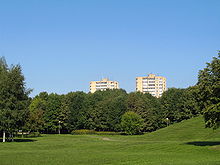
The Ninth Fort is a stronghold in the northern part of Šilainiai elderate, Kaunas, Lithuania. It is a part of the Kaunas Fortress, built in the late 19th century. During the Soviet occupation, the fort was used as a prison and way-station for prisoners being transported to labour camps. After the occupation of Lithuania by Nazi Germany, the fort was used as a place of execution for Jews, captured Soviets, and others.
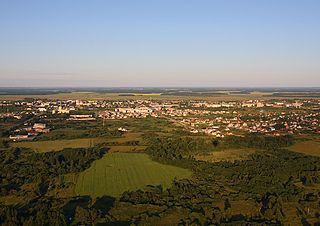
Radviliškis District Municipality is one of the seven municipalities of Šiauliai County in Lithuania. Radviliškis town has been its center since 1950.
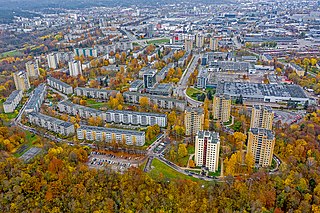
Žirmūnai is the most populous administrative division (elderate) in Vilnius. It is also a neighbourhood in the Lithuanian capital city Vilnius, encompassing the city district of the same name, built in the 1960s.

Žaliakalnis is a neighbourhood and eldership in Lithuania's second largest city, Kaunas. Žaliakalnis is located north of the old town and the city center area, between the Neris and Girstupis valleys. It is one of the largest residential areas in Kaunas, with a population of 38,480 in 2006.

Eiguliai is neighborhood in the city of Kaunas, Lithuania. Eiguliai elderate encompass Eiguliai, Kleboniškis and part of Kalniečiai neighbourhoods. Elderate itself is located on the left bank of the Neris River. The distance from Eiguliai neighborhood to Kaunas centre is approximately 6 km. The settlement was a small village until it was incorporated into Kaunas in 1959 and a residential microdistrict was built in 1979. The 7th Fort of the Kaunas Fortress are located in this eldership. The borough borders Dainava in the east, Žaliakalnis in the south, Vilijampolė and Šilainiai in the west and Domeikava with Lapės in the north. It has 40,453 inhabitants which represent 13.82 % of the population of Kaunas city municipality.
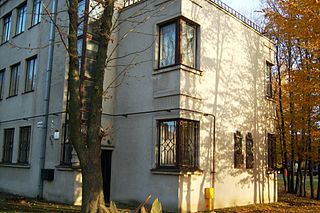
Vydūnas alley is a street in Kaunas, Žaliakalnis neighbourhood, bordering Ąžuolynas park in the north.

Gričiupis is a neighborhood of the Lithuanian city of Kaunas, located on the right bank of the Nemunas River. It has elderate status, and is the smallest elderate in the city. Its administrative status as an elderate was established in 2005, when it was detached from Dainava elderate. In 2021 its population was 23,894 in an area of 3.81 square kilometers.

Panemunė Eldership is an eldership in Kaunas County, Lithuania, encompassing Kaunas neighbourhoods of Panemunė, Vaišvydava, Vičiūnai, and the village of Rokai. Located on the left bank of the Nemunas River, it was formally incorporated into Kaunas in 1931. It occupies 24.78 hectares with 22,140 inhabitants.

Petrašiūnai is a neighborhood in the eastern part of the Lithuanian city of Kaunas. Part of larger Petrašiūnai elderate which also consists with Amaliai, Palemonas and Naujasodis neighorhoods. In 2006 it occupied about 28.46 km², with a population of about 18,000. Parts of elderate is on Kaunas Reservoir Regional Park.

Šančiai is an elderate in the Lithuanian city of Kaunas. It is located on the meandering right bank of the Nemunas River. Šančiai itself are divided into Žemieji Šančiai and Aukštieji Šančiai neighborhoods. Names come from their adjacent locations. Žemieji Šančiai is located in the Nemunas River valley, while Aukštieji Šančiai is located on the hill above the valley. Its entire elderate population of 2007 was 23,237.

Šilainiai is a neighborhood in the Lithuanian city of Kaunas, consisting of mostly Soviet-built microdistricts completed in the 1980s. Part of larger Šilainiai elderate which is one of the largest elderates in the city, consisting of Milikoniai, Sargėnai, Šilainiai, Vytėnai and Romainiai neighborhoods, covering 25 km2 and housing over 55,000 people as of 2021. Eighth and Ninth Forts of the Kaunas Fortress are located in the elderate.

Vilijampolė is a neighborhood in the city of Kaunas, Lithuania, located on the right bank of the Neris River and the Nemunas River, near their confluence. Part of a larger Vilijampolė elderate which consists of Vilijampolė, Lampėdžiai, Panerys, and Veršvai neighorhoods, and covers 1,720 hectares with population of 23,687 people.

Ąžuolynas is a public park in Lithuania's second largest city, Kaunas, in the Žaliakalnis elderate. The park covers about 84 hectares and is the largest urban stand of mature oaks in Europe. Vydūnas Alley serves as the park's northern border. It is a popular recreational destination for the inhabitants of Kaunas. Most of its trees are oaks ranging in age from 100 to 320 years old, but it also holds linden, birch, and maple trees.
The Kaunas Museum for the Blind in Kaunas, Lithuania opened in 2005. It was the first museum for the blind in the Baltic States and one of the first in Eastern Europe.
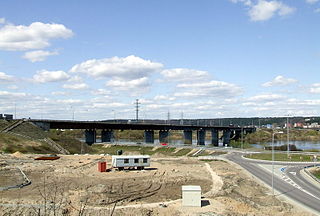
Lampėdžiai Bridge is a bridge in Kaunas, Lithuania. It crosses the Nemunas River to connect Marvelė in Aleksotas district and Lampėdžiai neighbourhood in Vilijampolė elderate. The bridge is 446 metres in length. It carries four lanes of automobile traffic, with two lanes in each direction. The bridge, completed in 1997, is also named after a Lithuanian roadman Česlovas Radzinauskas. Lampėdžiai Bridge is a part of Via Baltica and A5 highway of Lithuania, and western bypass of Kaunas.
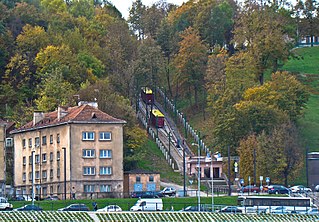
Aleksotas Funicular is a funicular railway located in Aleksotas elderate of Kaunas, Lithuania. The funicular constructed on the right bank of the Nemunas River was officially opened on 6 December 1935. The track of the Aleksotas funicular remained unchanged. The track has a separation in the centre of the track for carriages to pass. Special automatic brakes were installed in carriages not to let them run down in case of cable damage. The length of funicular is 132.9 metres (436 ft), gradient - 18 degrees. Authentic traction equipment, including the genuine pre-war wagons, wooden seats, and stop platforms of the funicular are still used.

Kaunas Eighth Fort, also known as Linkuva, is a former military fort in Šilainiai elderate, Kaunas, Lithuania. Built in 1889–1890, it is part of Kaunas Fortress, which was constructed by the Russian Empire. The Eighth Fort was the first element of Kaunas Fortress to use concrete. The structure is currently abandoned and semi-flooded. The slopes of the fort have been used since the interwar period as a community garden.

Church of the Most Sacred Heart of Jesus is a Roman Catholic church in Šančiai elderate of Kaunas, Lithuania.

The major administrative subdivisions of Kaunas, Lithuania, are elderates . They are further partitioned into traditional neighborhoods of two levels: "city parts" and "city territories".

Romainiai is a city part in the northwestern part of Kaunas, Lithuania, north of Lampėdžiai. It is part of the Šilainiai elderate.


